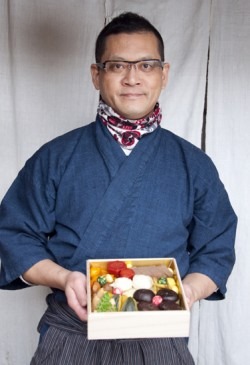
[A] trip to Kyoto is said to be incomplete without sampling its famous kaiseki cuisine, a sumptuous multi-course dinner which today can fetch up to $500 despite having originated in the demure tea ceremony. Less well-known but of similarly humble origins is shojin-ryori, the entirely vegetarian Buddhist cuisine that was first introduced to Kyoto monasteries from China in the 7th and 8th centuries.
Tanahashi Toshio, a renowned Kyoto-based chef, is convinced that shojin-ryori will come to the fore this century as the alternative to our meat-heavy, fat-saturated and wasteful diets.
At age 27, Tanahashi became an apprentice at Gesshinji Temple in Shiga Prefecture, a nunnery with tradition steeped in shojin cooking. In 1992, he opened Gesshinkyo, a highly-acclaimed shojin-ryori restaurant in Tokyo. In 2000, Vogue Nippon ran a series of articles on Tanahashi’s cooking and his story was dramatized for a TV series, “Honmamon” (The True Thing), on NHK.
Tanahashi has traveled extensively overseas, demonstrating the art of food presentation at the Victoria and Albert Museum in London and giving lectures and demonstrations at the Japan Society in New York and Boston. Tanahashi has been featured in numerous publications including The New York Times, The Sunday Times, The Japan Times and The Financial Times.
After closing Gesshinkyo in 2007, Tanahashi established the Zecoow Culinary Institute in February in Kyoto. He has recently retired from teaching “culinary arts and design” (shokugei食芸) at the Kyoto University of Art and Design to pursue his own projects. His books include Shojin — Wonder of Vegetables (2003), and The Power of the Vegetable: The Time for Shojin is Now (2008). Recently, Tanahashi opened a small shop, Sankyo, in central Kyoto where he sells sesame tofu, which he makes fresh everyday. He will lecture at Schumacher College this spring.
Kyoto Journal: Tell us a little bit about Shojin-ryori. What is at the heart of it?
Tanahashi Toshio: There is an essential concept, not only applied to the Shojin-ryori but to the whole of basic Japanese eating, that is, 一汁一菜 ichijuuissai, one soup, one dish. A traditional tray, ozen, is set with dishes on it. So, you put chopsticks here, a bowl of rice, a bowl of soup and a dish plate, you see. In this phrase, there is no 米 or rice. It is because it is taken for granted. So, this is the ideal combination.
Additionally, there is one other important food: tsukemono or pickles. So, rice and tsukemono are a must and are not counted in the phrase. This is the most basic style of Japanese food: most simple and the deepest.
In shojin-ryori, only plants are used. No meat, no fish; only grains and vegetables. Some say vegetables are a gift from God, from nature, whereas meat and fish are a secondary gift. Humans cannot make, for example, tomatoes. Only through sunshine, water and air are they created as a gift of food. We are able to live thanks to products that plants create for us, and without them we cannot: that is the absolute truth. Shojin-ryori is rooted in this fact. So, we shojin-ryori practitioners endeavor to take time with and cultivate passion for the plants that provide us with this truth.
“Sho” means “purify” and “jin” comes from the word for “advance.” In other words, it means to “move forward whilst respecting the old, and keeping oneself pure.”
Plants cannot speak, but we try to listen to their silent “voices.” Through persistent effort and daily encounters with vegetables, we come to grasp something essential about them. This message from the vegetables is then “translated” into shojin-ryori, which are in their best form for human consumption. We humans have shared thousands of years of history with plants, ever since we emerged on earth. And the genes in the some 60 trillion cells of our bodies are deeply entwined with plants. When vegetables are taken into our body in the best possible form, our cells are thus pleased.
Shojin-ryori is prepared with this in mind. But what food, other than meat, is the body not pleased by? We have a word, shun, which means “seasonal.” Today, artificially-cultivated vegetables are distributed all year round, without any regard for shun. Winter vegetables are harvested in summer; tomatoes are served at the table in wintertime. How disastrous this is for the tomatoes! We don’t want to eat tomatoes at the wrong time for them. Our body should reap the positive message of the seasons and allow nature to enter it most directly. To do that, we need to cook with seasonal ingredients when they are at their very best. In shojin-ryori, we merely assist in this.
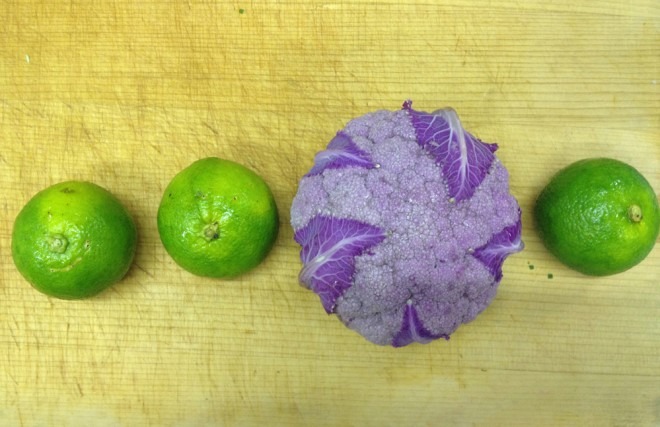
That’s why your food is so delicious!
Yes, but in fact I am not fond of the idea of “deliciousness.” This is a word for meat and fish. [Laughter] Once you learn how delicious they are, you become attached, like Eve’s apple. Within the spectrum of deliciousness, vegetables come further down the bottom. However, vegetables have their own unique flavor, and if you are open, you will discover it. In other words, as long as you maintain the idea that meat and fish are the main course and vegetables the side dish, you will never recognize it. Put it in reverse — think of vegetables as the main course, and then for the first time you will recognize how wonderful they taste. This will certainly mean nourishment for your cells. I’m afraid to say that our body is especially not pleased by meat, and the damage it does to us is terrible. It is no coincidence that our increased meat intake has led to an increase in the number of our ailments.
This is somewhat related to the cultures of wheat — or bread — and the cultures of rice. Many areas of the world maintain bread cultures. Asian countries practice rice culture. There is a fundamental difference between these two. Rice itself is a perfect food, containing proteins, vitamins, calcium as well as carbohydrates. Meanwhile, wheat has comparatively fewer nutrients, therefore it makes sense to eat meat with bread. Bread invites meat. We cannot survive by only bread, which requires supplemental proteins from meat. Rice is a wonderful plant and I believe it will be eaten more and more in the West. Since rice requires an abundance of water, another precious resource, there may be some environmental issues to deal with, however I think the custom of eating rice will spread.
Shojin cuisine does not strictly equate to vegetarianism. How are they different?
Shojin abides by Buddhism’s Five Prohibitions, the first of which is “don’t kill.” However, one of the most important teachings of Buddha is also to accept all suffering and pleasure with equanimity. The same is applied at the dinner table. Buddhists should receive all food that is offered, and not distinguish between meat and vegetables. So, Buddhists are in fact permitted to eat meat in certain cases. Out of choice, however, Shojin cuisine only uses vegetables.
Shojin cooking may seem limiting, but actually it is very liberating. Convenience will destroy humanity. Inconvenience leads to freedom.
Please tell us more about the freedom in limitation and simplicity.
Vegetables need more labor and skill to be prepared well, whereas meat and fish can be easily roasted or grilled. That is probably the main reason why it seems so incompatible with modern lifestyles. I tell my students to cook an all-vegetable dish once a week, and gradually a new sense is cultivated.
Now you make sesame tofu (goma-dofu) on a daily basis. Could you tell us more about that?
Sesame tofu has a long history, and is perhaps the most symbolic of all foods in Buddhist cuisine. It is very laborious and time-consuming to make. First you let the seeds sit in water overnight, before grinding them with a large mortar and pestle for about an hour. Then you harden it with kuzuko (arrow root powder). It may surprise you to know that major temples like Koyasan or Eiheiji, do not make sesame tofu like this anymore — rather, it is made from paste.
Where does sesame come from?
White sesame is from South America or Myanmar, black is from China. Japanese sesame is too small, and not appropriate for making goma-dofu.
The smell of sesame is really peaceful.
Plain sesame doesn’t give off that much of a scent but I slightly roast our sesame, which gives off a mild, sweet aroma while grinding.
Actually, the act of grinding the sesame is a form of meditation. Though usually meditation doesn’t usually produce something this tasty [laughter]. I kneel in seiza position, keep my muscles relaxed and control my breathing while I do so.
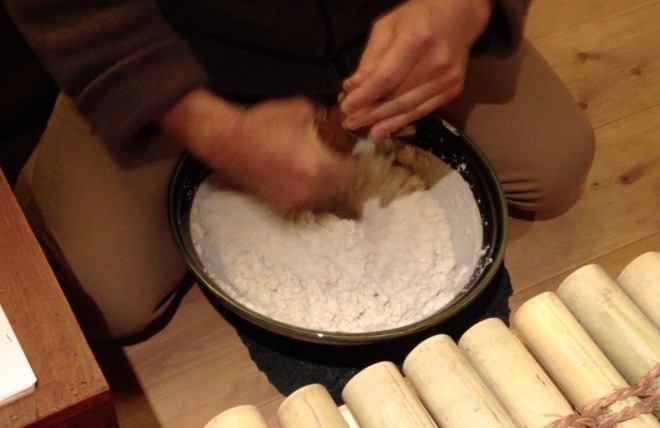
Where did you learn to make goma-dofu?
I learned while I was training at my temple, Gesshinji. The senior cook at the temple, or Anji-san, has retired now but most of what I learned came from her. This Anji-san lost the use of both her right arm and leg in an accident when she was 38. I watched her sitting on the hardwood floors in the cold kitchen, grinding sesame with just her left hand every day for three years. It would take her about three hours. Since she couldn’t hold a knife, the cutting was left to me. Even today I recall that scene and try to emulate her dedication.
I also learned an important phrase: “hocho wo hanase”.
What does that mean?
When you get good at cutting, you begin to enjoy it too much and take pride in it. One must be detached from one’s cooking. If you start cutting too much, you stray from your original path. Sometimes, when you go to large banquets you see these vegetables all cut up into minute, intricate shapes. It may look pretty, but from the point of view of shojin practictioners, this is just playing around: we don’t use vegetables for “ornamentation”: we bring vegetables “to life”. Hocho wo hanase literally means “to free oneself from one’s knife.”
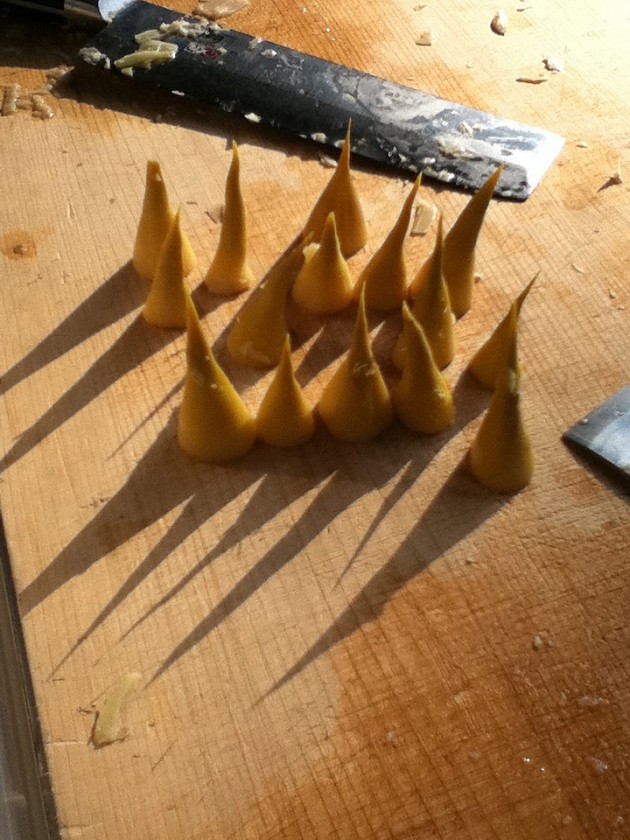
What else of importance did you learn from the Anji-san?
How to respond in a selfless, affirmative way, from the stomach: “Hai! ” (yes!). This is the most beautiful word in the Japanese language, and it is very important in the relationship between master and disciple. When the disciple responds in this way, the master can tell just how much they are paying attention, how much willpower they have, or if something else is on their mind. People who really listen, understand clearly, make an effort and who have nothing extra taking up their mental space, are able to give a good, solid “hai!” Nowadays many are incapable of doing this, so it is very difficult to tell what they are thinking. This is often due to bad posture too. A good posture is a virtue in Japan, a sign of beauty. One does almost everything sitting up straight in seiza, whether it is eating or writing poetry. I have written about just how important the word “zasu” [to sit properly] is. Unlike China, or Korea, where they sit kneeling on one leg with the other bent, seiza is unique to Japan, where both legs and feet are neatly folded under the posterior. This pose brings clarity of mind. That is why serving tea in this position becomes beautiful. Of course these days people are more interested in convenience and less tolerant of pain.
How would you educate about food in Japan?
The best time to teach children about food is when they gain monogokoro [awareness of the difference between the self and surroundings], and it should be the mother’s responsibility. Many mothers today, however, are improperly educated, so how can they teach their children?
To fix this problem requires study. I have often thought of creating special cafeterias in elementary and middle schools that would serve food made from local ingredients, but also be open to all. People of older generations would be particularly welcome, since they could teach kids what their mothers don’t know.
Don’t you think people are more aware about food since the Fukushima disaster?
Yes, but buying food from Tohoku out of pity for the farmers who can no longer sell their produce is something I cannot do. Recovering contaminated farmland is quite impossible. It may sound harsh and it must be difficult to abandon land that has been used for generations, but in my opinion, this is what these farmers must do. I know a farmer in Akita who every year has been selling me his mountain greens and wonderful mushrooms…
And among plants, mushrooms absorb the most radiation…
There is no other young man like him — well, still in their 40’s — daring to go into the mountains where bears roam to collect vegetables. There is special place known only to him where nameko mushrooms blanket the ground. Can you imagine such a place? It is heaven! Yet, because of the risks, I cannot bring myself to buy from him now.
Do you use ingredients with strong tastes like garlic in shojin cooking?
No. There are five pungent vegetables known as gokun [五葷] — niniku [garlic], tamanegi [onion], negi [spring onion, scallion], nira [Chinese chives], and nobiru [Japanese painted fern]. Gokun cause stress to the five organs (gozou): stomach, intestines, liver, spleen and pancreas. Garlic and onions are especially overused in Japanese households. When I eat food containing garlic, it stimulates my stomach and I have to rush to the rest room! My body can’t take it!
I want to give you a few words. Please say the first thing that comes to mind when you hear them. Ready? Myoga (Japanese ginger).
Myoga? A favorite. A friend of summer.
Maitake (a type of mushroom).
Tasty but dirty. It turns soups an unattractive, muddy color. Especially good in tempura. It does smells like a Ramen shop, though… [laughs]
Nagaimo (long yam).
I don’t use nagaimo often. It increases sex drive and most nagaimo you find in supermarkets are watery. Yamaimo [mountain yam] tastes good, but nagaimo is farmed. Do you know why they are straight? They are grown in straight sections of plastic hose. Naturally-grown nagaimo are more sinewy and twisted, and hard to dig up. They are strong, very sticky and thick. But there is clearly a preference for standardized vegetables, for instance, isn’t it odd that all cucumbers are straight too? “Imperfect” ones are thrown away. What stupidity!
Renkon (lotus root).
For me, renkon is the Buddha of vegetables. In the painting “yasai nehan” [Vegetable Nirvana], the famous Edo-period Japanese artist Ito Jakuchu [1716-1800] replaced the reclining image of the Buddha on his deathbed with a daikon [Japanese radish]. But instead of daikon, I would have used renkon, since Buddha is usually depicted seated on a hasu [lotus]. There is a saying: “Like a lotus flower that grows out of the mud and blossoms above the muddy water surface, we can rise above our defilements and sufferings of life.” The mud stands for shaba [the enduring of suffering, worldly desires, samsara].
Next, gin’an (ginkgo nuts).
The meiwakiyaku [side dish] of autumn. Partners well with sake too. The ginkgo tree is ancient, a living fossil. There are male and female trees, and the nuts grow only on females. How can something so delicious come from such a smelly tree!
“February”
The solstice, the beginning of spring. According to the traditional calendar, the year begins on February 4th, so when I think of February, I think of new beginnings. I associate February with root vegetables or konsai, like radish, daikon, carrot, lotus root. While you can’t see anything above ground, some plants are building a stock of food below ground. Vegetables spend the entire year getting ready to be edible. For us. In order for us to live. How amazing plants are!
I heard that 90% of Kyoyasai (Kyoto vegetables) come from outside of Kyoto.
Yes, it’s true. It has been over 10 years since the idea of chisan-chisho [“local production, local consumption”] was first promoted, but it hasn’t caught on at all.
Do you have a deshi (apprentice)?
No. People often take on many deshi indiscriminately. In my opinion, there should only be one in a lifetime. I myself was my master’s only apprentice. Master and apprentice are connected by something the eyes can’t see; a relationship that goes beyond that of parent and child. I have yet to meet anyone who is earnest about learning the art of shojin cuisine.
Seijoumuku (清浄無垢) means cleansing and purification.In short, the inside of the body gets dirty. Taking a shower can cleanse the outside of the body. The intestines especially get dirty by meat intake. Therefore, it is important to keep the inside of the intestines clean. What can clean the intestines are vegetables. Japanese people have longer intestines than the Westerners because of their rice-eating custom. If meat stays in the intestines longer it becomes poison.
So what I always mention at lectures — not a pleasant topic, I admit— is the subject of daiben (large bowel movement) and shoben (urine). The character “ben” has an alternative pronounciation of “tayori” (message, a letter). Come to think of it, daiben and shoben are in fact a kind of “letter” from your body — you eat food, and out comes a letter in reply! Toilets nowadays are built so that we can flush this letter away without having to “read” it — that’s no good. This letter is an indication of our body’s functioning, so it deserves proper attention!
Finally, what is the most important message you would like to get across?
I think it is more important to express one’s philosophy through actions instead of words: in other words, I would like people to eat and experience shojin cuisine using their gokan (the five senses). Explanation is all very well, but true understanding does not come without listening to the silent voice of vegetables. You must put effort into facing the things that you cannot see with your eyes or hear with your ears to find an answer. That is Buddhist cuisine.
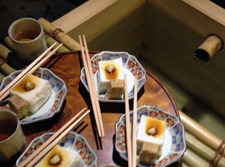
How to make Sesame Tofu
Yield: 16 servings
Ingredients:
400 g white sesame seeds (untoasted)
8 cups water
less than 2 cups Yoshino kudzu starch
1tsp salt
1 cup sake
soy sauce and grated wasabi to taste
seasonal garnishes for decoration
Instructions:
1.
Soak sesame seeds in plenty of water overnight. Strain and rinse. Strain again.
2.
Place the sesame seeds into the suribachi (Add 4 cups of water and grind thoroughly. Move the surikogi in a circular motion until the mixture takes on a smooth consistency (you will notice the sound of grinding getting lower).
3.
Add 4 more cups of water and blend. Pour mixture through a bleached cotton cloth into a large pot. Make sure to squeeze out all the liquid.
4.
Place a small strainer in the pot. Put kudzu, salt and sake in the strainer. Blend the mixture by hand until all lumps disappear.
5.
Remove the strainer and place the pot over high heat. Stir continuously with a wooden spatula, making sure not to let it burn. After approximately 10 minutes, the mixture will thicken. Keep stirring vigorously for 10 more minutes, until the mixture becomes completely smooth.
6.
Pour the mixture into a slightly wet mould (16.5 centimeters by 21 centimeters by 4.5 centimeters) and let cool. Cover the surface with plastic wrap and place the container in cold water. After about one hour in winter (two in summer), transfer the sesame tofu to a wooden cutting board. Cut into 16 pieces and place in a bowl of water. Serve on a plate with soy sauce, topped with grated wasabi. Decorate with something seasonal, such as an autumn leaf.
Recipe from Toshio Tanahashi of Gesshinkyo



